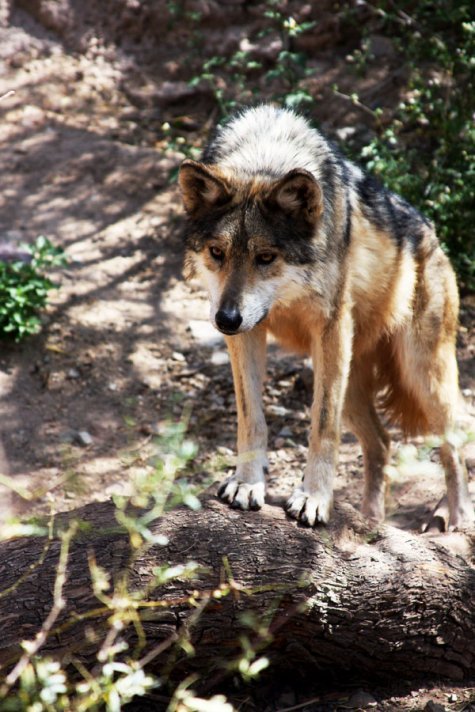Future Still Uncertain for Mexican Gray Wolf
 A Mexican gray wolf at the Arizona-Sonora Desert Museum stands on a rock looking out of its enclosure. (Photo by Kaite Flynn)
A Mexican gray wolf at the Arizona-Sonora Desert Museum stands on a rock looking out of its enclosure. (Photo by Kaite Flynn)
Mexican wolf F521 was born in captivity at the Cheyenne Mountain Zoo in Colorado Springs, Colo., in 1997 as part of the Mexican Wolf Recovery Program managed by U.S. Fish and Wildlife Service.
Later, F521 was brought to a wildlife refuge pre-release facility in New Mexico. She was paired with a male, M507. The wolves bred in captivity and were released into the wild with a litter in 2002.
The Bluestem Pack was born and became one of the most prolific packs in Mexican wolf recovery.
Reintroduction has had its success stories like F521 and her Bluestem Pack, but the recovery program is still struggling.
Currently, the Blue Range Wolf Recovery Area, which stretches from New Mexico into Arizona, is the only area authorized to carry out recovery, said Michael Robinson, a conservation advocate with the Center for Biological Diversity.
Until reintroduction began, there were no Mexican wolves anywhere in the wild and they were considered extinct, he said.
The larger grouping — the gray wolf — has been protected under the Endangered Species Act since 1973. But in 2009 the Center for Biological Diversity started a petition to separately list the Mexican wolf, a subspecies of the gray wolf, as endangered.
U.S. Fish and Wildlife Service will review the petition and see if the listing of the species is warranted, said Maggie Dwire, assistant recovery coordinator.
Robinson said that despite federal protection of the gray wolf, the Mexican wolf is possibly the most endangered animal in North America.
There are 42 Mexican wolves in the wild, 15 in New Mexico and 27 in Arizona, with only two breeding pairs, Robinson said. There are, however, breeding facilities with about 330 wolves waiting to be reintroduced, Robinson said.
The decline in Mexican wolf population has numerous causes, including targeted killing, disease and genetic problems.
In 1915 the Bureau of Biological Survey, later renamed U.S. Fish and Wildlife Service, started to systematically poison, trap and shoot Mexican wolves on domestic lands, Robinson said.
With decades of trapping and killing, the population has declined, he said. Because of the decline, U.S. Fish and Wildlife Service and other agencies have switched gears and are now working to recover the species.
Reintroduction began in 1998, but research by the Center for Biological Diversity shows the wolf population continues to decline. In 1999, there were 21 new releases. The number plunged to zero in 2007.
In 2009, release of captive wolves became impossible when a nasal tumor resulted in the death of the pack’s alpha male, said Susan Dicks, a U.S. Fish and Wildlife Service biologist. The puppies in the pack also died, and the female was moved to New York where she will remain in captivity for the rest of her life, Dicks said.
Another obstacle could be genetic issues, Dicks said. Biologists are closely monitoring genetics to determine which wolves to release, she said.
Ranchers on public lands are another problem, said Dave Parsons, a conservation advocate and former U.S. Fish and Wildlife Service employee.
“Up until just recently, they’ve put way too much focus and priority on resolving conflicts in a way that wolves always pay the price,” Parsons said.
When a conflict arose in the past, the solution was to take wolves out of the picture, he said.
In 2005, U.S. Fish and Wildlife Service policy was to remove any wolf that attacked three cattle per year. This continued until 2008.
Another problem is illegal shootings. Since 1998, there have been 33 reported illegal killings in the Southwest, Parsons said. There are limited circumstances when someone can shoot a wolf. But, the law currently states that if a wolf is on private land and in the act of killing livestock, the landowner can shoot and kill it, Dwire said.
Ranchers and farmers with livestock still have concerns.
“Those who depend on livestock for income, you know, aren’t going to be too concerned if they perform an illegal act against an endangered species,” said Nick Robbs, a University of Arizona student whose family owns and operates Robbs Farm in Wilcox.
“If it’s eating your income, you’ll kill it and bury it,” he said.
A Mexican gray wolf paces in its enclosure at the Arizona-Sonora Desert Museum. (Photo by Kaite Flynn)
U.S. Fish and Wildlife Service says it will be working to facilitate more releases and build public tolerance for wolves in the wild, Dicks said.
A primary focus for U.S. Fish and Wildlife Service is to develop a revised recovery plan that includes wolves.
The original goal was to have 100 Mexican wolves in the wild by 2006. The program is still working on hitting the mark, Dicks said.
But without a new recovery plan there is no deadline. However, Dwire said that she’s optimistic. She said she hopes to reconvene a recovery team within the next year.
For now, plans for the number of wolves U.S. Fish and Wildlife Service wants in the wild are still on hold. But the success of F521 shows that recovery is possible, she said.
The story above, written by Kaite Flynn, appeared in El Independiente on April 12, 2010.



